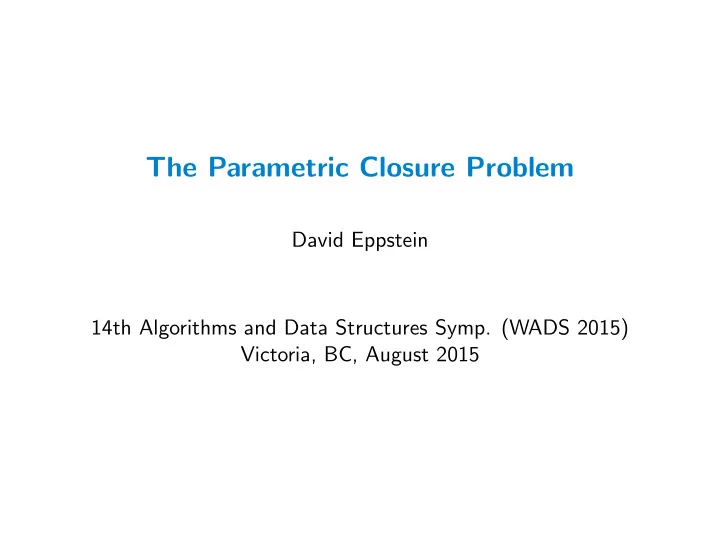

The Parametric Closure Problem David Eppstein 14th Algorithms and Data Structures Symp. (WADS 2015) Victoria, BC, August 2015
The closure problem Find max-weight downward-closed subset of a partial order Classical example: open-pit gold mining Sunrise Dam Gold Mine, Australia. CC-BY-SA image “Sunrise Dam open pit” by Calistemon on Wikimedia commons. Elements = blocks of ore Partial order = must remove higher block to access lower one Weight = value of extracted gold − extraction cost
Bicriterion closure problem Optimize a nonlinear combination of two different sums of element values E.g. return on investment: Find downward-closed subset of partial order achieving max profit/cost, where ◮ Profit is sum of extracted CC-BY-SA image values of chosen ore blocks “13-02-27-spielbank-wiesbaden-by-RalfR-066” by Ralf Roletschek from Wikimedia commons ◮ Cost is sum of extraction costs of chosen ore blocks
Parametric closure problem Element value is a linear function of an unknown parameter: value = amount of gold extracted × price of gold − extraction cost Goal: construct the (convex piecewise linear) function mapping each parameter value to its optimum closure PD image “Gold price in USD” by Realterm on Wikimedia commons
Converting bicriterion to parametric problems Whenever a bicriterion problem maximizes a quasiconvex function of its two arguments x and y , its optimum can be found as one of the parametric optima for λ x + y Quasiconvex: all lower sets { ( x , y ) | f ( x , y ) ≤ θ } are convex x/y ≤ 0.25 x/y ≤ 0.5 x/y ≤ 1 x/y ≤ 2 x/y ≤ 4 Example: return on investment f ( x , y ) = x / y , with x , y > 0
Classical results ◮ Closure problem has a polynomial time solution (reduction to min cut) ◮ Parametric and bicriterion solutions for other problems (especially minimum spanning trees and shortest paths) ◮ Several isolated problems that in retrospect fit into this framework Detail of Raphael’s School of Athens , with Plato and Aristotle
New contributions ◮ Formulation of parametric and bicriterion closure problems ◮ Equivalence to natural problems in combinatorial geometry (complexity of polytopes constructed by combinations of Minkowski sums and convex hulls of unions) ◮ Efficient solutions for several important classes of partial orders, but not for the general problem Ukiyo-e image of blind monks examining an elephant, by Itcho Hanabusa
A geometric point of view Replace parametric weight f ( p ) = ap + b by geometric point ( a , b ) abcd Ø: 0,0 abcd : 2,0 c : –7 p + 10 d : 8 p + 6 abc abd bd : 1,–4 abc : –6,–6 a : 8,–6 ab bd b : –7,–10 abd : 9,–10 a b a : 8 p – 6 b : –7 p – 10 Ø ab : 1,–16 Given a partial order (left), the candidate solutions (center) map to points in the plane (right) Then parametric optima form the upper part of the convex hull (the value of p determines the slope of a tangent to the hull)
Series-parallel partial orders Series composition of orders: all elements of one order are Series composition below all elements of the other Parallel composition: Parallel composition no relation between the elements of the two orders Corresponding operations on convex hulls: convex hull of union, Minkowski sum Neither operation increases #vertices ⇔ parametric problem has O ( n ) solutions
Series-parallel parametric closure algorithm Geometric problem: evaluate expression tree of polygons in Minkowski which each operation is either sum hull of union or Minkowski sum union union Hull of union: merge sorted hull hull sequences of vertex x -coords, union hull local fixup for nonconvexities Minkowski sum: merge sequences of edge slopes Using dynamic finger trees, logs telescope ⇒ O ( n log n ) time
Semiorders: preferences with uncertainty Each element has a numeric utility value Partial order = numeric order, unless values are too close n – 1 n – 1 beyond the margin of error s ) s ( e e r f indices out of order 0 0 0 n – 1 0 n – 1 We use a quadtree to form series-parallel subproblems, showing: Parametric closure problem has O ( n log n ) solutions They can be found in time O ( n log 2 n )
More partial orders with good solutions Bounded width (no large antichains) ◮ typical version control edit histories Transitive reduction has bounded treewidth ◮ fence poset reduction is a path Incidence posets of graphs ◮ elements are vertices and edges ◮ each edge ≥ its endpoints A Fibonacci cube, the family of closures of a fence poset ◮ used to model depot location as closure
Conclusions Some answers, but more questions: ◮ Do general posets have polynomially many parametric closures? ◮ Is there any family of posets with more than linearly many parametric closures? ◮ What is the complexity of higher-dimensional expression trees of union-hulls and Minkowski sums? CC-BY-SA file “Question in a question in a question in a question” by Khaydock from Wikimedia commons
Recommend
More recommend